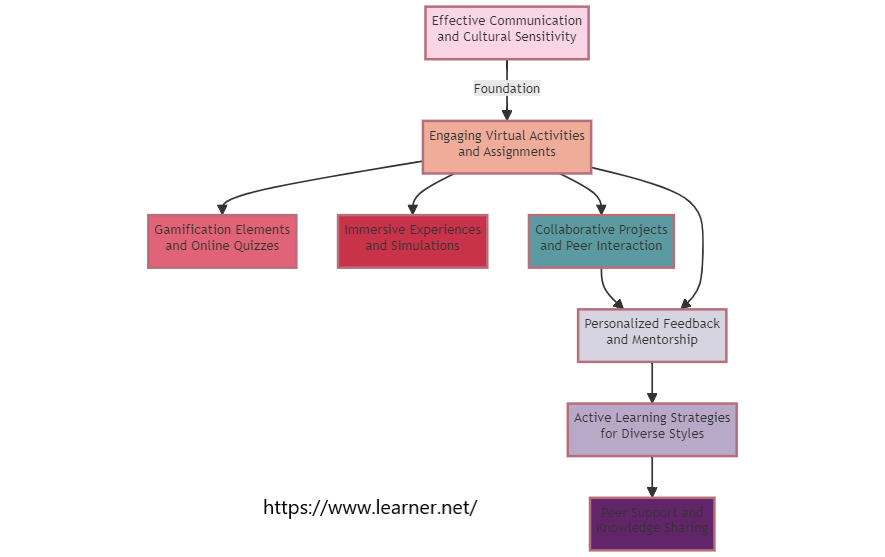Creating a safe student learning space for distance learners is necessary for many reasons, including encouraging a more positive educational experience, and for the health and mental well-being of both the online tutor and the student. Amidst the digital revolution in education, distance learning has witnessed a remarkable surge in popularity. As of the latest available data from UNESCO, over 1.5 billion students worldwide have experienced disruptions in their traditional learning environments, underscoring the widespread adoption of remote education.
This seismic shift brings with it some unique challenges, especially on an international scale where students and tutors may grapple with diverse cultural contexts and time zone disparities as well as language barriers. Navigating this global educational landscape, it becomes imperative to emphasize the creation of a safe, engaging, and culturally inclusive learning space that prioritizes the mental health and well-being of all participants as well as a positive learning environment conducive to a more direct and enhanced personalized approach to education.
Consider the widespread story of students globally facing the challenge of adapting to an online education format, encountering not just academic hurdles but also cultural nuances. Educators strive to deliver effective lessons while understanding the diverse backgrounds of their students. Their experiences encapsulate the multifaceted nature of distance learning on an international scale.
Cultural differences, language barriers, and varying time zones create a complex tapestry that students and tutors must navigate. The virtual classroom becomes a melting pot where diverse perspectives converge, demanding a nuanced approach to create an inclusive, safe, and healthy digital learning space. In this scenario, the imperative is not just to deliver academic content but to foster an environment that embraces cultural diversity and supports the mental health and well-being of all participants.
The essence of distance learning lies not just in the transmission of knowledge but in the creation of a safe and engaging virtual community. The isolation inherent in remote education, compounded by cultural disparities, poses potential challenges to mental health. Feelings of disconnection, academic stress, and cultural alienation may emerge. Tutors, too, face the responsibility of understanding the unique needs of their students and creating an environment that supports their well-being.
To address these challenges, educational institutions and online tutors must prioritize the creation of inclusive learning spaces. This involves recognizing and celebrating diversity, incorporating culturally sensitive and relatable teaching examples and practices, and providing resources to support the mental health of all participants.
Virtual classrooms should implement measures such as regular mental health check-ins, culturally relevant content and reference materials, and collaborative projects that foster cross-cultural interactions. These strategies can contribute to the creation of a more inclusive and supportive and safe virtual learning environment.
Cultural inclusive references in distance learning go beyond mere acknowledgments, but require active integration into the pedagogical approach as well as the lesson plans. Tutors must cultivate an awareness of the cultural backgrounds of their students, weaving cultural relevance into lessons.
Incorporating diverse perspectives, promoting open discussions on global issues, and encouraging students to share their unique experiences are integral components of creating an inclusive virtual classroom. By doing so, distance learning becomes a space where cultural diversity is not an obstacle but a catalyst for enriching the learning experience.
Furthermore, addressing the mental health challenges associated with distance learning necessitates proactive measures. Educational institutions and even the online tutors should invest in support services and relevant materials, providing students with access to counseling resources and mental health professionals.
Tutors, in turn, should be equipped with the tools to recognize signs of distress and offer the appropriate assistance, bearing in mind any potential conflicts based on cultural differences. Virtual support networks stand as a testament to the importance of establishing resources for students to seek help when needed.
The global surge in distance learning reflects a paradigm shift in education. The experiences of students and educators globally epitomize the challenges and opportunities intrinsic to this transformation. To ensure the well-being of all participants, the creation of a safe, engaging, and culturally inclusive learning space becomes imperative.
As educational institutions and online tutors continue to adapt to the intricacies of distance learning, embracing diversity, prioritizing mental health, and leveraging technology become crucial elements in shaping the future of global education.
The Internationalization Imperative For A Safe Student Learning Space
The increasingly digital landscape of education is witnessing a surge in distance learning programs, fueled by an influx of international students seeking academic mobility and flexible learning options, and in some cases, access to better educational opportunities than have been traditionally made available to them in some locations. Another United Nations report revealed a near doubling of online student enrollment since 2019, with international participation leading the way among distance learners. While this trend unlocks doors for knowledge exchange and cultural understanding, catering to diverse demographics necessitates tackling unique challenges to nurture truly inclusive and equitable learning environments.
The demand for distance learning courses from international students stems from several factors. Geographic constraints, access to specialized programs, and the flexibility to balance studies with personal commitments play a significant role. Additionally, online platforms often offer cost-effective options compared to traditional on-campus programs, particularly for students from developing countries. This creates a level playing field, opening doors for broader access to high-quality education.
International students navigating distance learning encounter obstacles that can impede their academic success and inhibit personal development. Language barriers remain a primary hurdle, with misunderstandings arising from differences in vocabulary, grammar, and cultural nuances.
Furthermore, time zone disparities can disrupt communication and collaboration, potentially leading to missed deadlines and frustration. Cultural differences in pedagogical approaches and learning styles can further amplify these challenges, creating a sense of isolation and disengagement for some students.
To foster a safer and more inclusive learning space for international students, online tutors must adopt deliberate and distinct tutoring strategies. Localization, the tailoring of content and materials to specific cultural contexts, references, and languages, is crucial. This involves translating resources, incorporating local references and examples, and adapting teaching methods to align with familiar learning styles.
Utilizing technology like the Learner Net AI Teaching Assistants for real-time translation, to engage with more interactive platforms, and to present additional collaborative activities can further break down language barriers and promote cross-cultural interaction.
Prioritizing mental health and well-being is equally important. Regular communication, flexible scheduling options, and access to mental health resources can alleviate anxieties and isolation often associated with distance learning. Building a supportive community, fostering a sense of belonging within the virtual classroom, and promoting open communication channels can significantly enhance the learning experience for international students.
Effective teaching methods remain paramount in creating a successful distance learning environment. Utilizing interactive tools, gamification elements, and personalized feedback can assist the online tutor in catering to more diverse learning styles and keeping students actively and personally engaged in their online lessons. Additionally, incorporating virtual field trips, collaborative projects, and discussions that transcend borders can enrich the learning experience and promote active participation.
The internationalization of distance learning presents both opportunities and challenges. By acknowledging the unique needs of international students, adopting strategies for localization and technology integration, and prioritizing mental health and well-being, online programs can foster safe and inclusive learning spaces. This commitment to inclusivity paves the way for knowledge exchange, cultural understanding, and academic success for students from diverse backgrounds, ensuring that the global classroom flourishes as a vibrant hub of learning and collaboration.
Engaging Across Borders: Effective Localization and Globalization Strategies For Online Tutors
The digital classroom and online educational institutions have shattered geographical barriers, bringing together students and tutors from across the globe. However, navigating this new frontier of education demands more than just technological prowess. To foster more safe and engaging learning spaces for international students, online tutors must be adept at bridging cultural divides, and this begins with understanding the power of localization and globalization for online education.
Consider the seemingly innocuous example of a barbecue. In the United States, it represents a wholesome family gathering, sizzling dogs (or hotdogs), steaks, and burgers and laughter filling the air. Yet, imagine portraying this very scene to a student from India, where cows are revered as sacred. Suddenly, the image becomes culturally insensitive, potentially creating an atmosphere of discomfort and disrespect. This scenario underscores the fundamental principle of “localization” or adapting course content, materials, and teaching methods to specific cultural contexts and languages.
Effective localization goes beyond mere translation. It requires sensitivity to often subtle nuances, recognizing that humor, geographical references, and even seemingly neutral imagery can hold vastly different meanings across cultures. To illustrate this, imagine a tutor explaining the concept of democracy using references to ancient Greek mythology. While perfectly suitable for a Western audience, this approach might alienate a student from a Confucian-influenced background, where emphasis lies on historical figures and filial piety.
Therefore, successful localization demands strategic adjustments. Consider translating jokes with culturally relevant equivalents, replacing unfamiliar locations and historical figures with local features and heroes, and incorporating case studies rooted in the students’ own cultural context. Engaging with these localized materials fosters a sense of ownership and relevance, transforming the learning experience from passive absorption to active participation and a deeper interest in the subject matter.
Involving international students directly in the localization process is also crucial. Their feedback helps identify potential blind spots, ensuring that adaptations remain authentic and respectful. Imagine a tutor collaborating with students from diverse backgrounds to revise lesson plans, incorporating their customs and perspectives into the learning materials. This participatory approach not only enhances inclusivity but also enriches the content with diverse viewpoints and experiences.
However, localization alone cannot bridge the cultural gap entirely. This is where “globalization” enters the online realm, aiming to create universally accessible and personally engaging learning experiences suitable for a global audience. Technology plays a central role in this endeavor as well, again emphasizing the valuable tools made available on Learner Net in the form of the AI Assistants for online tutors.
Interactive platforms enable increasingly collaborative projects and cross-cultural discussions, allowing students to share their perspectives and learn from each other in a safe and secure online environment. Multimedia resources, such as videos and infographics, can transcend language barriers by presenting information visually, while real-time translation tools facilitate seamless communication, fostering a sense of connection and collaboration.
Yet, globalization, like localization, necessitates a mindful approach. While platforms and tools can break down linguistic barriers, true cultural understanding comes from open dialogue and shared experiences. Collaborative activities that delve into diverse traditions, cross-cultural discussions that explore different perspectives, and even virtual field trips that showcase contrasting environments are all effective tools for promoting cultural exchange and understanding.
Engaging international students in distance learning requires a nuanced approach that balances localization and globalization. By carefully adapting content to specific cultural contexts, embracing technology to create universally accessible experiences, and actively fostering cultural exchange, online tutors can transform the digital classroom into a vibrant and healthy safe space for learning, growth, and mutual understanding.
In the modern, increasingly borderless world, effective communication and cultural sensitivity are no longer mere pedagogical tools. The principles of localization and globalization become the keys to unlocking the full potential of international education, forging connections that transcend geographical boundaries and enriching the lives, personal growth, and mental health of both students and online tutors alike.
Prioritizing Mental Health and Well-being in Online Educational Environments
While it may be true that the surge of online education has opened doors to expanded knowledge and global connections, within this digital landscape also lurk hidden challenges, including the potential for isolation, stress, and anxiety for both students and tutors, particularly in international settings. While the convenience and flexibility of virtual classrooms are undeniable, the absence of physical proximity can exacerbate feelings of loneliness and disconnection, impacting academic performance and overall well-being. Therefore, prioritizing mental health and creating not only safe, but supportive digital educational environments has become crucial to the continued success of online education.
The unique challenges faced by international students and tutors deserve some special attention. Language barriers, time zone disparities, and cultural differences can lead to misunderstandings, missed deadlines, and frustration, adding layers of stress to the already demanding nature of learning and teaching. Students may grapple with feelings of isolation and cultural displacement, while tutors may struggle with effectively communicating across diverse backgrounds and managing asynchronous schedules.
To navigate these challenges, online educational platforms must prioritize strategies that promote mental well-being. Establishing clear communication channels and fostering regular check-ins, both formal and informal, are essential. This ensures students feel heard and supported, while allowing the online tutors to monitor their well-being and identify potential problems early on. Offering flexible scheduling, free and open lines of communication, and workload management options, further empowers students to take control of their learning pace and reduce stress, while at the same time allowing online tutors to maintain their work-life balance and prevent burnout.
Access to mental health resources and support groups is another crucial element. Partnering with mental health professionals to provide online consultations, organizing peer support groups, and sharing resources on mindfulness and stress management can equip both students and tutors with tools to cope with anxiety and isolation. Cultivating a supportive and understanding community within the virtual learning environment is equally important. Encouraging positive interactions, fostering cultural exchange, and promoting collaborative activities can combat feelings of loneliness and build a sense of belonging.
Technology can play a pivotal role in fostering mental well-being. Implementing virtual communication tools that facilitate open dialogue and collaborative learning can bridge the physical distance and promote connection. Utilizing chat functions, the Learner Net AI Assistants, online forums, and video conferencing tools allows students to interact with peers and tutors in real-time, fostering a more personal sense of community and belonging. Additionally, incorporating features like progress tracking and personalized feedback can empower students to take ownership of their learning and boost their confidence, reducing stress and anxiety.
Finally, recognizing and addressing the well-being and mental health of online tutors is equally vital. Providing tutors with the means to interact in culturally sensitive environments among their peers, and to enhance their international communication skills, can equip them to handle the more diverse needs and navigate challenging situations effectively with some help from their newfound friends and peers. Regular professional development opportunities, access to support networks for educators, and promoting healthy work-life balance practices can go a long way in preventing burnout and fostering a positive teaching environment.
Prioritizing mental health and well-being in online education is not a luxury, but a necessity. By acknowledging the unique challenges faced by students and tutors, particularly in international settings, and implementing strategies for clear communication, flexible scheduling, access to resources, and community building, online educational platforms can create safe and supportive havens where learning flourishes alongside well-being. In this way, we can ensure that the journey through the digital classroom is not one of isolation and anxiety, but a path towards knowledge, connection, and shared growth for all.
Diagram 1: Building Safe and Inclusive Online Learning Environments for Distance Education

How Online Tutors Can Enhance the Digital Learning Experience
While effective communication and cultural sensitivity may form the bedrock of successful online tutoring, the potential for a truly enriching experience lies in venturing beyond these fundamental aspects. To captivate international students within the digital classroom, online tutors must employ pedagogical strategies that ignite curiosity, spark collaboration, and cater to a diverse range of unique learning styles.
Interactive and engaging virtual activities and assignments play a pivotal role in transforming passive knowledge consumption into active learning. Gamification elements, such as points systems and leaderboards, can fuel a spirit of friendly competition and incentivize participation. Online quizzes with immediate feedback provide opportunities for self-assessment and targeted learning.
Utilizing virtual environments, AI Assistants, and even full simulations allows students to immerse themselves in different contexts and apply their knowledge in interactive scenarios. These immersive experiences may be used to cater to diverse learning styles and keep students engaged, fostering a sense of ownership over their learning journeys and creating a strong bond and sense of community in the online educational institutions.
Collaboration and peer-to-peer interaction across cultures add another layer of enrichment to the digital classroom. Collaborative projects that transcend geographical boundaries, such as creating multimedia presentations or writing comparative essays, encourage students to share perspectives, solve problems together, and learn from each other’s strengths. Online forums and discussion boards can break down geographical barriers and promote asynchronous communication, allowing students to learn from and challenge each other’s ideas beyond real-time sessions. This collaborative learning fosters intercultural understanding and develops valuable communication skills, preparing students for a globalized world.
Personalized feedback and mentorship opportunities further elevate the learning experience. Tailoring feedback to individual needs and learning styles allows students to identify strengths and weaknesses, guiding them towards continuous improvement. Regular check-ins and one-on-one virtual conferences offer a platform for personalized guidance and mentorship, building trust and fostering a supportive learning environment. This focus on the individual ensures that each student’s unique needs are met, propelling them towards their academic goals.
Incorporating active learning strategies that cater to diverse learning styles ensures inclusivity and maximizes engagement. Utilizing visual aids, such as infographics and videos, alongside text-based materials, caters to visual learners. Kinesthetic learners can benefit from virtual simulations and interactive activities that involve movement and hands-on exploration. Auditory learners can be engaged through podcasts, audio presentations, and online discussions. By employing a variety of teaching methods, tutors ensure that all students have opportunities to excel, regardless of their preferred learning style.
Furthermore, the online environment presents unique opportunities for peer support and knowledge sharing among online tutors themselves. The Learner Net Social networking platform can connect tutors from across the globe, fostering a sense of community and shared purpose.
Through active communication on these platforms, tutors can learn how their peers and even the more experienced ones have conquered similar challenges in diverse cultural contexts. This peer-to-peer support and shared knowledge network empower tutors to constantly improve their techniques, adapt to new situations, and ultimately, create and maintain safe and healthy digital learning environments for their students.
Enhancing the digital learning experience for international students requires more than just effective communication and cultural sensitivity. By employing interactive activities, encouraging collaboration, providing personalized feedback, and using diverse teaching methods, online tutors can transform the virtual classroom into a vibrant space for active learning, intercultural understanding, and personal growth. And through platforms like Learner Net, online tutors themselves can tap into a global network of peer support and shared knowledge, further empowering them to create and maintain safe and effective learning environments for their students, ensuring that the digital classroom becomes a haven for meaningful learning and intercultural connection.








There are no reviews yet.